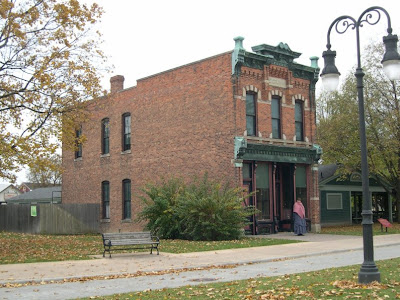Richart Wagon Shop (formerly known as Richart Carriage Shop and Macon Wagon Shop)
 Originally known in its original Macon, Michigan location as the Richart Wagon, Farm Implement, and Repair Shop, this structure was built in 1847. Henry Ford brought this necessity of the 19th century to his Village in 1941.
Originally known in its original Macon, Michigan location as the Richart Wagon, Farm Implement, and Repair Shop, this structure was built in 1847. Henry Ford brought this necessity of the 19th century to his Village in 1941.
Although handcrafted wagons and buggies were the chief product of their carriage shop, William and Robert Richart also produced, as stated in its original title, farm implements, and even furniture. Bobsleds were a major product made and sold here as well during the winter months.
This two story building was built with an outdoor ramp to the second floor, where painting of the product took place. This ramp allowed the carriages easy access to (and from) the ground level.
 From the research I have found comes a very interesting "flesh-on-the-bones" description of 19th century life with the Richart's:
From the research I have found comes a very interesting "flesh-on-the-bones" description of 19th century life with the Richart's:
The seasonal nature of life in Macon is one of the most interesting finds in the ledgers. Summer typically busied the Richarts with tool and wagon repairs, their own small farming interests, and improvements to their homes. But as the leaves changed, so did the daily routine in the wagon shop; Summer wagon building and repair yielded to fall duties; William and Robert, during the time of autumn, spent many a day with a file in their hands sharpening saws for neighbors and other members of their community, for it would be difficult to store wood for the winter with a dull blade! Frequently, during the months of October and November, barrels of apple cider appeared not only as purchases, but as payments as well.
 And winter presented its own occupations that included construction and repair of sleds and cutters.
And winter presented its own occupations that included construction and repair of sleds and cutters.
Once spring finally came along, farmers preparing for the summer once again brought the Richarts their broken wagons, hoes, cradles and other farm tools.
 Their carpentry skills made the Richarts sort of community handymen. They built picture frames, a dough trough, a dresser, breakfast table and bee hives. They repaired chairs, sawmills and even a dog house. Robert hung the blackboard in the schoolhouse and worked at butchering. William worked on a stone boat clearing the fields and made furniture. . . .
Their carpentry skills made the Richarts sort of community handymen. They built picture frames, a dough trough, a dresser, breakfast table and bee hives. They repaired chairs, sawmills and even a dog house. Robert hung the blackboard in the schoolhouse and worked at butchering. William worked on a stone boat clearing the fields and made furniture. . . .
 Mass production helped the business along during the last quarter of the century. Rather than hand forming wheel spokes, shafts, rims and hubs, William increasingly ordered them from supply houses. Purchases of '500 spokes' are numerous for example. Interestingly, there are only one or two references to carriages in the five decades covered by the account books, presenting a conflict with the name currently given the structure. William and Robert both considered themselves 'wagon makers' and wagon construction and repair formed the backbone of their business.
Mass production helped the business along during the last quarter of the century. Rather than hand forming wheel spokes, shafts, rims and hubs, William increasingly ordered them from supply houses. Purchases of '500 spokes' are numerous for example. Interestingly, there are only one or two references to carriages in the five decades covered by the account books, presenting a conflict with the name currently given the structure. William and Robert both considered themselves 'wagon makers' and wagon construction and repair formed the backbone of their business.
 And to think all of this took place while working out of this building 150 years ago!
And to think all of this took place while working out of this building 150 years ago!
Indeed, this wonderful addition to Greenfield Village has always been one of my favorites.
Now, if they'd only put a costumes presenter inside...
.



Comments